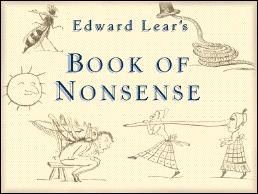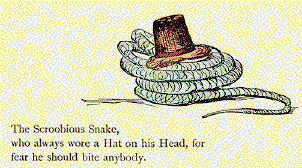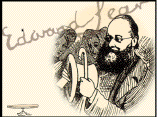

Edward Lear's Book of Nonsense.

Written and illustrated by Edward Lear.
Edited by Simcha Shtull.
Israel: MAXIMA New Media Ltd., 1995.
46pp, hard-cover book with CD (including 3 audio tracks and one CD-ROM track), $24.95.
ISBN: 1-888297-01-8.
Subject Headings:
Children's poetry, English.
Nonsense verses, English.
Limericks, Juvenile.
Grades 3 and up / Ages 8 and up.
Review by Theresa Yauk.
**/4
excerpt:
`How pleasant to know Mr. Lear!'
Who has written such volumes of stuff!
Some think him ill-tempered and queer,
But a few think him pleasant enough.
His mind is concrete and fastidious,
His nose is remarkably big;
His visage is more or less hideous,
His beard it resembles a wig."
 Of course, the above was written by none other than Edward Lear himself, and is included in Edward Lear's Book of Nonsense. This multimedia set celebrates the 150th anniversary of the publication of Lear's first Book of Nonsense, -- evidence of the timeless appeal of Lear's work. The attractive hard-cover book includes Lear's simple and comic black-and-white illustrations.
Of course, the above was written by none other than Edward Lear himself, and is included in Edward Lear's Book of Nonsense. This multimedia set celebrates the 150th anniversary of the publication of Lear's first Book of Nonsense, -- evidence of the timeless appeal of Lear's work. The attractive hard-cover book includes Lear's simple and comic black-and-white illustrations.
The accompanying CD contains narration of all the verse contained in the book, read beautifully by Yonny Lucas. The music contained on these tracks is appropriate for the verse, and is very upbeat and engaging. Effects such as birds trilling (to accompany a rhyme about birds) also further entertain the listener and provide an excellent addition to the book.
The problem with this package is that the book and audio CD tracks are so well done that the publishers really should have decided against the CD-ROM track, and included more material in the other formats. The CD-ROM track contains little in the way of animation. For instance, the "More Botany Nonsense" and "More Funny People" sections only have illustrations and text. These segments would have been better included in the book and on the audio portion of the CD.

Though the graphics on the CD-ROM are clear, computer images generally look best in colour. But the understated, black-and-white lines of Lear's illustrations are most suited to print. Why use the CD-ROM format when no improvement can really be made to the original format, and when there is little interaction between the user and the CD-ROM? This seems a case where the publisher has jumped on the CD-ROM bandwagon, without much thought to the appropriateness of the format.
Though I have mentioned that I quite enjoyed both the book and the audio tracks, both are too short. Other versions of Lear's works run two hundred or more pages, while this book has only forty-six. Though the book is made well, is very readable and attractive, it provides only a limited amount of Lear, even when coupled with the CD-ROM track. As the set stands, it's hard to recommend.
While the book and accompanying narration are delightful, they would have to contain more of Lear's verse to be worth the price, and that could only happen if the publishers hadn't tried to include too many formats in one set.
Not recommended.
Theresa Yauk works in the Special Services department at the Winnipeg Centennial library; she previously worked in the Children's Department for six years. She is currently studying for a Master's degree in Library and Information Science.
To comment on this title or this review, send mail to cmeditor@mts.net.

Copyright © 1996 the Manitoba Library Association.
Reproduction for personal use is permitted only if this copyright notice
is maintained. Any other reproduction is prohibited without permission.
Published by
The Manitoba Library Association
ISSN 1201-9364

CONTENTS FOR THIS ISSUE |
WELCOME


![]()
Of course, the above was written by none other than Edward Lear himself, and is included in Edward Lear's Book of Nonsense. This multimedia set celebrates the 150th anniversary of the publication of Lear's first Book of Nonsense, -- evidence of the timeless appeal of Lear's work. The attractive hard-cover book includes Lear's simple and comic black-and-white illustrations.
![]()
![]()